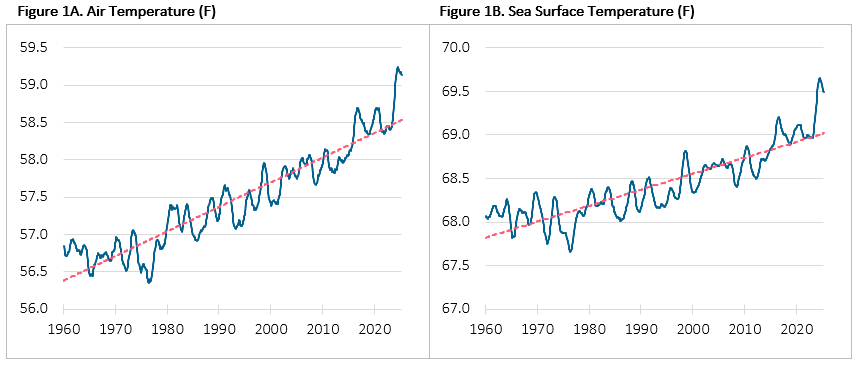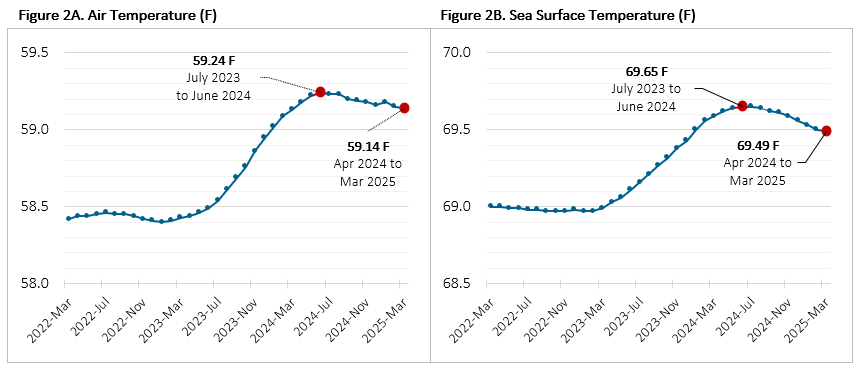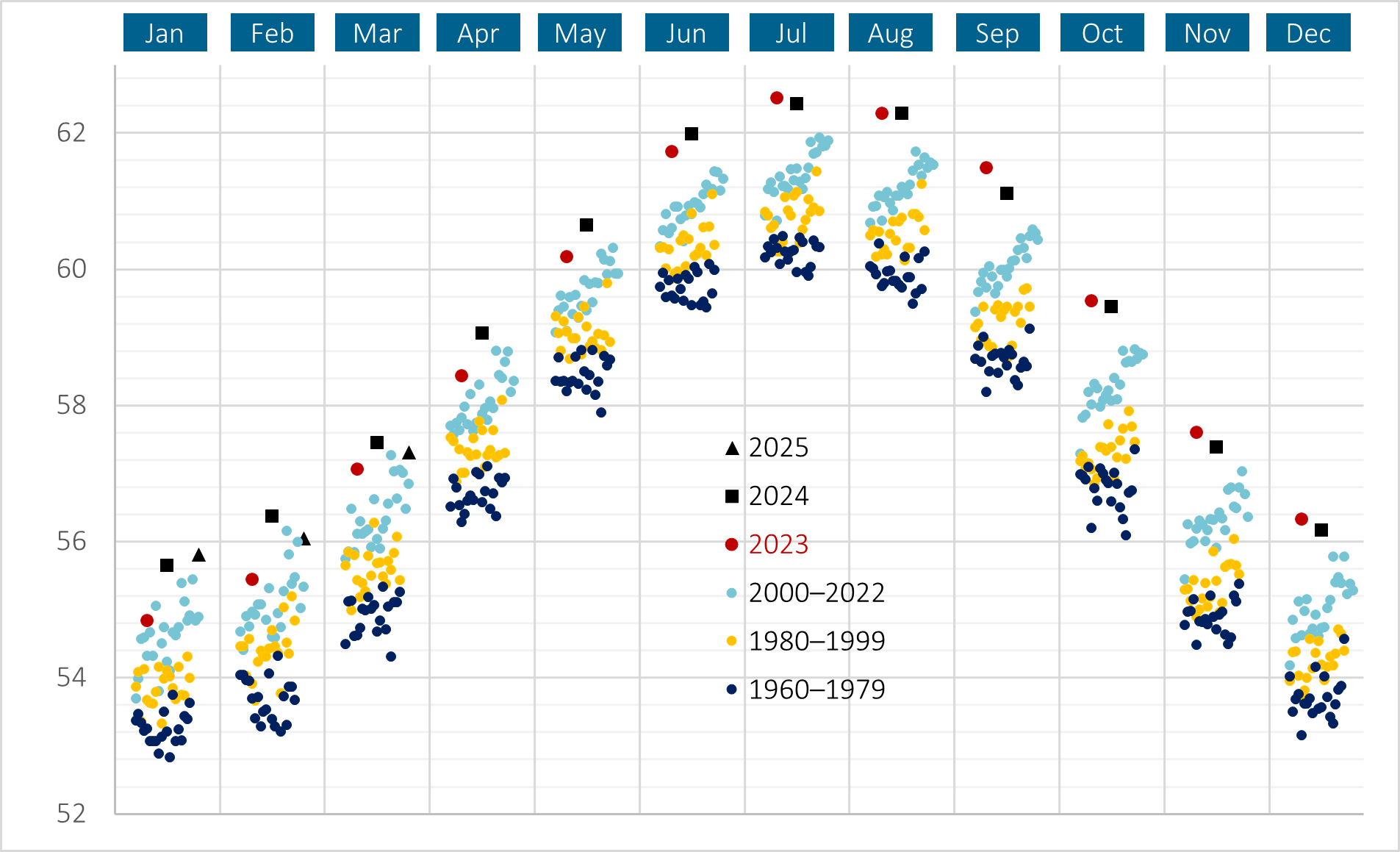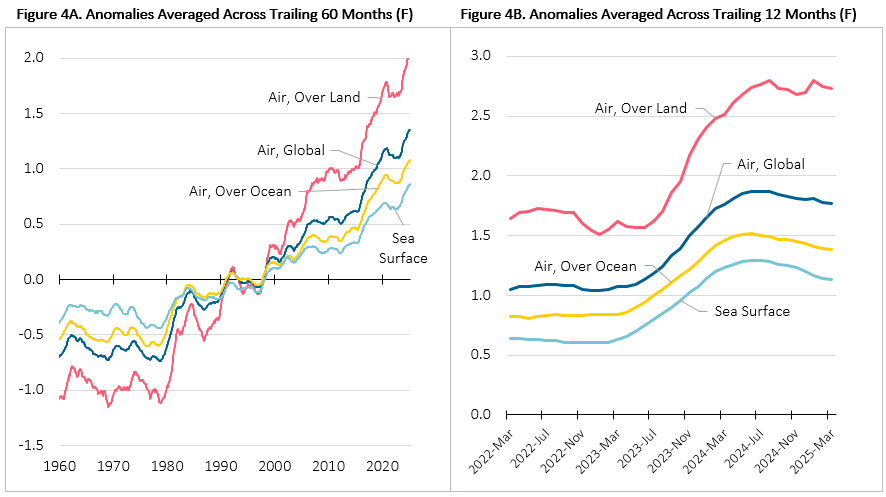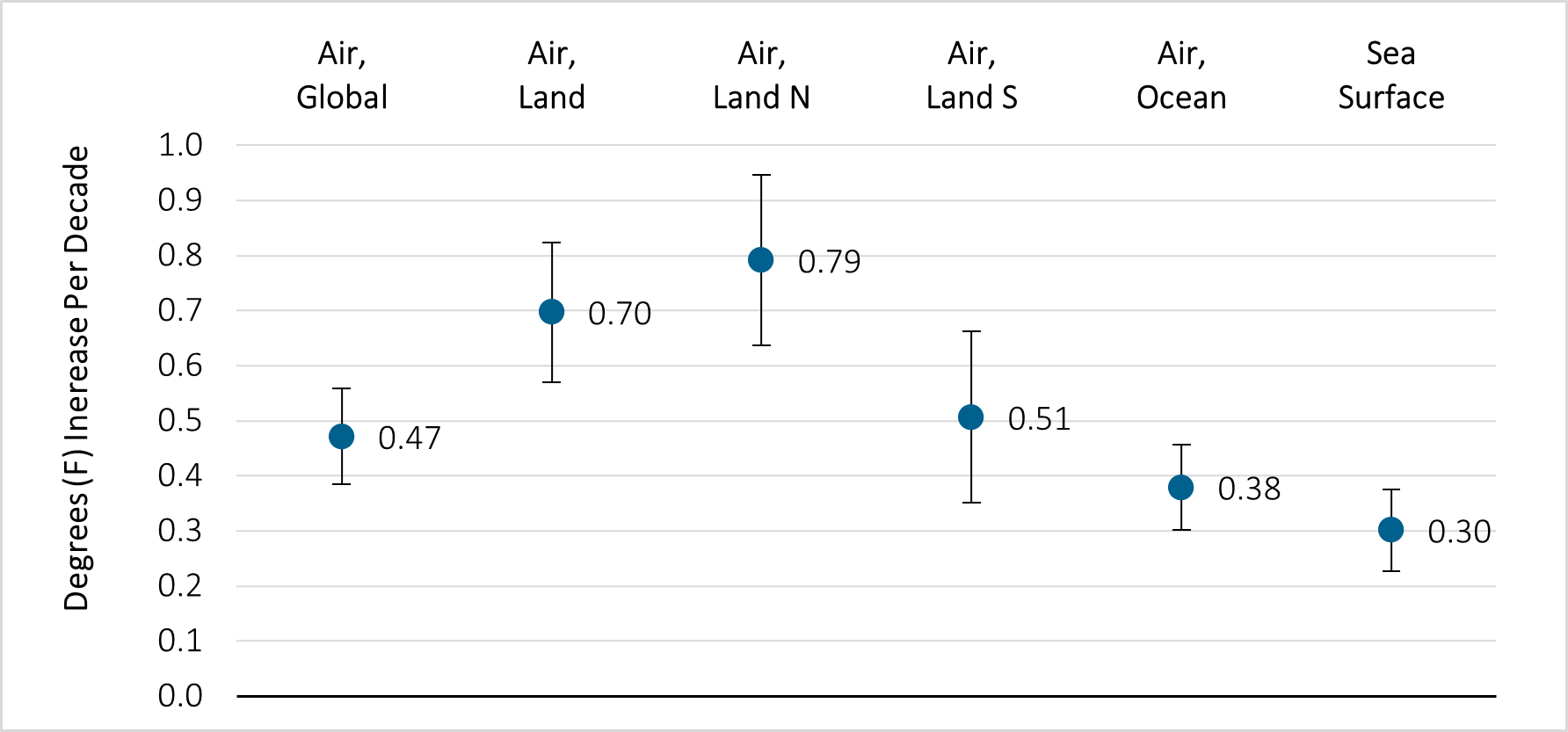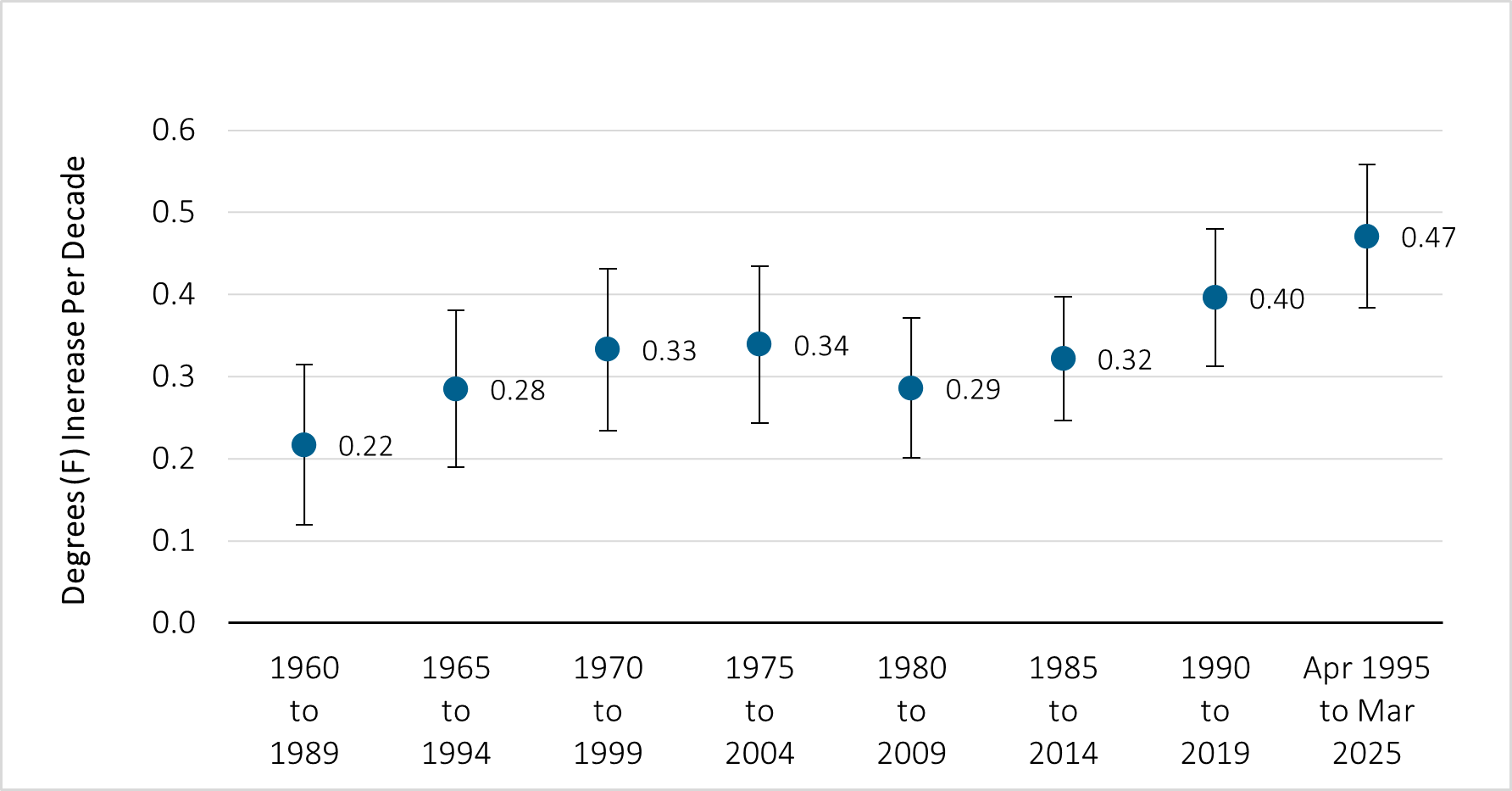Quarterly Global Warming Report
Overview
The SOA Research Institute has, in recent years, issued several reports that provide a statistical summary of global warming trends. Because of the importance of this topic to the insurance industry and to society at large, an updated report will be released quarterly on this page, reflecting the latest air and sea-surface temperature data from the ERA5 dataset.
About the Dataset
ERA5 is a comprehensive weather dataset produced by the European Centre for Medium-Range Weather Forecasts (ECMWF). ERA5's data runs from 1940 to the present, and provides coverage of the entire surface of the earth. Because ERA5 offers excellent spatial and temporal coverage, it is frequently used by climate scientists to study temperature trends.
Report Updates
This updated report examines ERA5 air and sea-surface temperature data from 1960 through March 2025. Relative to the prior report, this report captures three additional months of data: January, February and March of 2025. The report compares recent temperatures against long-run averages and provides estimates of long-run warming trends.
Materials
- Quarterly Warming Report 2025 Q1
- Exhibit – ERA5 monthly temperature data for 1960 to March 2025
- Exhibit – interactive Tableau map of the temperature data
Podcast
Quarterly Global Warming Report 2024 Overview
Highlights
Some of the highlights of the report are presented in the graphs below. To see a detailed description of a given graph, click on the “Figure Details” below the graph.
Figures 1A and 1B
12-Month Trailing Average of Global Temperature From Jan 1960 To Mar 2025
Figures 1A and 1B Details (click to view)
Figures 1A and 1B show the 12-month trailing average of global average air temperature and global average sea surface temperature (SST), respectively. Air temperature is averaged across the earth’s entire surface, while average SST excludes latitudes north of 60N and south of 60S (an approach that is commonly used by climate scientists to compute average SST). The figures reveal strong long-term warming trends, with recent global temperatures climbing to record-high levels. Using linear regression, the estimated long-term trend is +0.33F per decade for air temperature, and +0.18F per decade for SST.
Figures 2A and 2B
12-Month Trailing Average of Global Temperature from Mar 2022 to Mar 2025
Figure 2 Details (click to view)
Figures 2A and 2B present the same data as in Figures 1A and 1B but focus solely on the time period from Mar 2022 to the present. The graphs reveal that the 12-month trailing averages of air temperature and sea surface temperature (SST) rose steadily from January 2023 through June 2024. For both air temperature and SST, a peak was reached in June 2024 (reflecting data from July 2023 through June 2024). Since then, the 12-month trailing averages have declined slightly, but remain near their record highs.
Figure 3
Global Average Air Temperature (F) By Month
Figure 3 Details (click to view)
Figure 3 shows global average air temperature for each separate month (as opposed to the rolling 12-month averages show in Figures 1 and 2).
It is worthwhile to briefly explain the seasonal cycle of global average air temperature that is apparent in Figure 3. This seasonality may seem counterintuitive given that, on a global level, the earth receives about the same total amount of solar energy per day throughout the year. When the northern hemisphere experiences fall and winter, the southern hemisphere experiences spring and summer, and vice versa. Less daylight in one hemisphere is counterbalanced by more daylight in the opposing hemisphere. This suggests that the global average temperature should remain roughly constant from one month to the next. However, the northern hemisphere contains over two-thirds of the earth’s land mass, and, in general, land heats up more quickly than does water in response to a given influx of solar energy. Consequently, global average temperature carries a strong signature of the northern hemisphere’s seasonal temperature changes.
Figures 4A and 4B
Trailing Average of Global Temperature Anomalies
Figures 4A and 4B Details (click to view)
In the parlance of climate scientists, temperatures defined relative to their corresponding long-term averages are termed “temperature anomalies”. The anomalies in Figures 4A and 4B are defined relative to 1960–2019 averages. The figures present anomalies of four temperature metrics: (1) air temperature averaged across the entire surface of the earth, (2) air temperature over land areas, (3) air temperature over oceans, bays, and lakes; (4) and sea surface temperature (SST). To better illustrate long-term trends, Figure 4A shows anomalies averaged across trailing 60-month periods, from 1960 to the present. The final 60-month period runs from April 2020 through March 2025. Figure 4B focuses solely on the period from March 2022 to the present and uses a 12-month averaging period rather than 60 months. The final 12-month period captured in Figure 4B runs from April 2024 to March 2025. Figure 4A reveals that global average air temperature has risen faster than average SST, and air temperature over land has risen faster than air temperature over oceans.
Figure 5
Estimated Warming Trend for The 30-Year Period from Apr 1995 to Mar 2025
Figure 5 Details (click to view)
To estimate warming trends for air temperature and sea surface temperature (SST), linear regresions were run across the most recent 30 years of data. A period of 30 years is long enough to cancel-out short-term climate cycles such as El Nino and La Nina which can influence global temperatures. The slope of each regression line provides an estimate of the rate-of-warming. Best estimates for trends are represented by blue dots, while the vertical bars represent 95% confidence intervals.“Air, Land” is air temperature averaged across all land areas, while “Air, Land N” and “Air, Land S” capture solely the land areas in the northern and southern hemispheres, respectively. “Air, Ocean” is air temperature across all bodies of water. “Sea surface” is the average water temperature across the surface of oceans and other bodies of water.
Figure 6
Estimated Warming Trend: Degrees (F) Increase Per Decade
Figure 6 Details (click to view)
To assess whether the rate of global warming is changing across time, linear regressions were run across the following overlapping 30-year periods: 1960 to 1989, 1965 to 1994, 1970 to 1999, 1975 to 2004, 1980 to 2009, 1985 to 2014, 1990 to 2019, and April 1995 to March 2025. Focusing on global air temperature, the estimated warming trend for the most recent 30-year period is 0.47F per decade, which is greater than the rate for any prior 30-year period. The graph’s vertical bars represent 95% confidence intervals for the warming trend. The blue dot at the center of each vertical bar indicates the “best” estimate produced by the regression.
Contact
If you have comments or questions, please send an email to research@soa.org.

